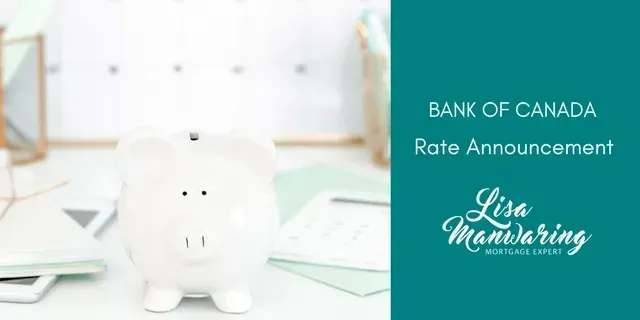Using your RRSP for a downpayment through the HBP.
Lisa Manwaring • February 17, 2021

As the March 1st, 2021 RRSP deadline approaches for the 2020 tax season, if you have money saved for a downpayment but you’re not quite ready to buy a home, here’s a little strategy that might interest you. Did you know that you can use the money saved in an RRSP as a downpayment? It’s called the Home Buyers’ Plan, or HBP for short.
Instead of keeping your downpayment tucked away in a savings account or TFSA, consider using your savings to purchase an RRSP before this year’s RRSP deadline. This will lower your taxable earnings for 2020 and trigger a (bigger) tax refund or lessen the amount of tax you have outstanding. You can then use the money saved towards your goal of homeownership. Admittedly, this won’t play a huge role in building a downpayment, but in times like these, every bit counts!
So here are some of the criteria for using the Home Buyers’ Plan.
You must be considered a first-time homebuyer to use the HBP.
This means you have either never bought a home previously, or, in the last four-year period, you did not occupy a home that you or your current spouse or common-law partner owned.
You have 15 years to pay back the RRSP
with payments starting in the second year after the withdrawal. While you won’t pay any tax on the money withdrawn from your RRSP for the downpayment, you will have to pay back the total amount you withdrew over 15 years. The CRA will send you an HBP Statement of Account every year, and your repayments will not count as new RRSP contributions as you’ve already received the tax break from those funds.
Funds have to be in your RRSP for at least 90 days to be eligible
for use in the HBP. This is a rule not many people are aware of, but it’s pretty important. So if you decide to purchase an RRSP with your savings to be used as part of your downpayment for withdrawal through the HBP, you need to wait at least 90 days before buying a home to make everything work. If you decide to buy a home before the 90 days is up, the RRSP purchase can still be withdrawn, but it will negate the tax savings.
You can access up to $35,000 ($70,00 per couple)
from your RRSP account to be used as a downpayment through the HBP. The government increased the accessible amount in 2019.
You can learn more about the Home Buyers' Plan by checking out the CRA website here. Or, if you’d like to discuss how the HBP could work for you and your personal financial situation, contact me anytime!
RECENT POSTS

Bank of Canada maintains policy rate at 2.1/4%. FOR IMMEDIATE RELEASE Media Relations Ottawa, Ontario December 10, 2025 The Bank of Canada today held its target for the overnight rate at 2.25%, with the Bank Rate at 2.5% and the deposit rate at 2.20%. Major economies around the world continue to show resilience to US trade protectionism, but uncertainty is still high. In the United States, economic growth is being supported by strong consumption and a surge in AI investment. The US government shutdown caused volatility in quarterly growth and delayed the release of some key economic data. Tariffs are causing some upward pressure on US inflation. In the euro area, economic growth has been stronger than expected, with the services sector showing particular resilience. In China, soft domestic demand, including more weakness in the housing market, is weighing on growth. Global financial conditions, oil prices, and the Canadian dollar are all roughly unchanged since the Bank’s October Monetary Policy Report (MPR). Canada’s economy grew by a surprisingly strong 2.6% in the third quarter, even as final domestic demand was flat. The increase in GDP largely reflected volatility in trade. The Bank expects final domestic demand will grow in the fourth quarter, but with an anticipated decline in net exports, GDP will likely be weak. Growth is forecast to pick up in 2026, although uncertainty remains high and large swings in trade may continue to cause quarterly volatility. Canada’s labour market is showing some signs of improvement. Employment has shown solid gains in the past three months and the unemployment rate declined to 6.5% in November. Nevertheless, job markets in trade-sensitive sectors remain weak and economy-wide hiring intentions continue to be subdued. CPI inflation slowed to 2.2% in October, as gasoline prices fell and food prices rose more slowly. CPI inflation has been close to the 2% target for more than a year, while measures of core inflation remain in the range of 2½% to 3%. The Bank assesses that underlying inflation is still around 2½%. In the near term, CPI inflation is likely to be higher due to the effects of last year’s GST/HST holiday on the prices of some goods and services. Looking through this choppiness, the Bank expects ongoing economic slack to roughly offset cost pressures associated with the reconfiguration of trade, keeping CPI inflation close to the 2% target. If inflation and economic activity evolve broadly in line with the October projection, Governing Council sees the current policy rate at about the right level to keep inflation close to 2% while helping the economy through this period of structural adjustment. Uncertainty remains elevated. If the outlook changes, we are prepared to respond. The Bank is focused on ensuring that Canadians continue to have confidence in price stability through this period of global upheaval. Information note The next scheduled date for announcing the overnight rate target is January 28, 2026. The Bank’s next MPR will be released at the same time.

What Is a Second Mortgage, Really? (It’s Not What Most People Think) If you’ve heard the term “second mortgage” and assumed it refers to the next mortgage you take out after your first one ends, you’re not alone. It’s a common misconception—but the reality is a bit different. A second mortgage isn’t about the order of mortgages over time. It’s actually about the number of loans secured against a single property —at the same time. So, What Exactly Is a Second Mortgage? When you first buy a home, your mortgage is registered on the property in first position . This simply means your lender has the primary legal claim to your property if you ever sell it or default. A second mortgage is another loan that’s added on top of your existing mortgage. It’s registered in second position , meaning the lender only gets paid out after the first mortgage is settled. If you sell your home, any proceeds go toward paying off the first mortgage first, then the second one, and any remaining equity is yours. It’s important to note: You still keep your original mortgage and keep making payments on it —the second mortgage is an entirely separate agreement layered on top. Why Would Anyone Take Out a Second Mortgage? There are a few good reasons homeowners choose this route: You want to tap into your home equity without refinancing your existing mortgage. Your current mortgage has great terms (like a low interest rate), and breaking it would trigger hefty penalties. You need access to funds quickly , and a second mortgage is faster and more flexible than refinancing. One common use? Debt consolidation . If you’re juggling high-interest credit card or personal loan debt, a second mortgage can help reduce your overall interest costs and improve monthly cash flow. Is a Second Mortgage Right for You? A second mortgage can be a smart solution in the right situation—but it’s not always the best move. It depends on your current mortgage terms, your equity, and your financial goals. If you’re curious about how a second mortgage could work for your situation—or if you’re considering your options to improve cash flow or access equity—let’s talk. I’d be happy to walk you through it and help you explore the right path forward. Reach out anytime—we’ll figure it out together.


